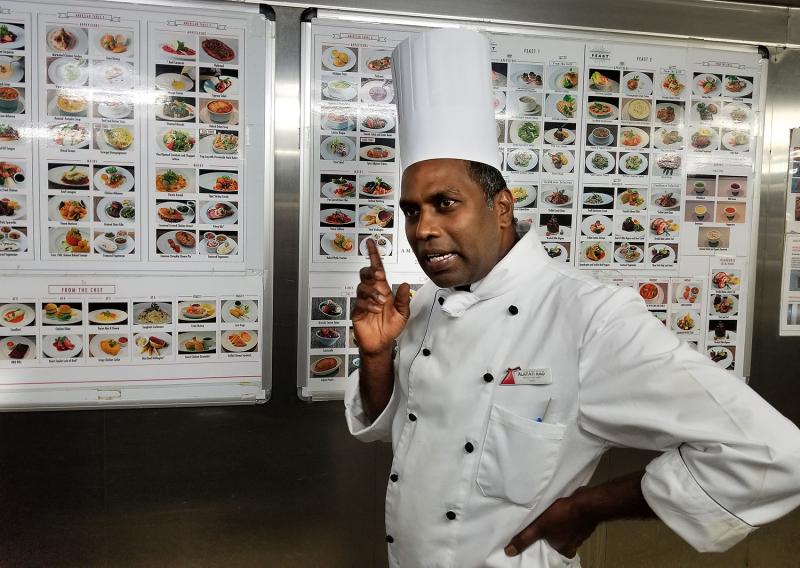A peek into the hidden world of cruise ship cookery
One of the facts of life in The Business of Eating is that a piece of bacon will probably cost you less if you're feeding three restaurants full of people rather than just one. Restaurateurs love to throw around the term "economy of scale," referring to the rather obvious fact that the more restaurants you own (i.e., the more people you can accommodate at the same time) the less your costs will be, simply because you can buy in bulk.
That works well for three, four or even 10 restaurants. But how about a food service organization that operates eight restaurants (a couple of which seat around 500 people and are within walking distance of one another)? Add 24-hour delivery, upwards of 12 bars (also within walking distance, and several of which have two shifts of live entertainment) - and breakfast, lunch and dinner for employees. Now that's economy of scale.
I witnessed just that sort of organization last week on board the Carnival Pride cruise ship. I was honored to be the "cruise personality" for Delaware 105.9, one of the four Delmarva Broadcasting Company radio stations that serve central Delaware. Thanks to DBC and Cindy McCabe from Bethany Travel, I got to spend a week on board this self-contained floating city with a gaggle of radio people, their faithful listeners and those who love them. As the host of two on-air food shows, one of my duties was to conduct several kitchen tours. I didn't expect that I would learn more about high seas hospitality than I ever imagined possible.
We were hosted by Carnival's 25-year veteran Executive Chef Alapati Rao, who oversees the 24-hour madness contained in paragraph two above. The Pride kitchen dishes up 18,000 meals a day for ship's crew and their weekly guests. The onboard staff is made up of about 700 people of over 60 nationalities, each of whom would love a taste of their native land from time to time. Chef Alapati is supported by three shifts of sous chefs and 124 kitchen workers who toil 24/7 for their approximately eight months of onboard duty rotation. Main dining rooms are seated in two shifts, and serving tray-laden waitrons are shuttled from the kitchen to the dining decks via escalators.
Carnival owns 10 cruise brands. The Carnival-branded ships alone number 25. And the behind-the-scenes action in the hospitality division boggles the mind. We spoke of economy of scale: The weekly food cost for just the Carnival Pride (not their biggest ship, by the way) is $250,000.
A cruise ship is a closed system. (No quickie mid-week deliveries from local suppliers.) All the food is sourced through the U.S. and is overseen by the CDC in Atlanta in order to control and track where and when each and every one of the 1,300 on-board food items either flew, grew, grazed, swam, crawled or otherwise scampered. Onboard chefs like Alapati minimize waste by making use of every item in the most efficient way possible. So, tonight's prime rib entrée might be tomorrow's beef pâté appetizer. And the dinner baked potato might make a cameo appearance the next morning as crispy hash browns. The lunchtime garlic bread might reappear on a salad a few hours later as a savory crouton. Solid food waste (e.g., bones - after they are reduced for soup/sauce stock) is incinerated down to ash, and soft food waste deemed consumable by marine animals is recycled out to sea. Interestingly, cruise ships are prohibited from ejecting soft food waste into smaller bodies of water like the Chesapeake Bay and are tracked by satellites to ensure compliance.
Consistency and predictability are key to planning on this massive scale. Numerous stations in the ship's kitchens display detailed photos of how each dish must look before it is escalated up to the guest. Each portion is carefully calculated to make sure the ship doesn't run out of food before returning to port. Busy restaurants on land employ a similar process by calculating "pars" for each item they serve. An equation that tracks previous sales weeks or months back, the weather, local events, etc., etc. is often utilized to help chefs order enough product to keep their customers happy, but not so much that food is wasted and costs increase accordingly.
Ships of this magnitude take great pains to keep this noisy, high-energy beehive of activity safely out of view of their vacationing customers. But it's an entirely different situation for the servers, runners and wine stewards who are committed to making the guest's experience a happy one. After my second tour of the kitchen last week, I commented to one of the main dining room servers how impossibly huge the kitchens are. He smiled and responded, "They start out big, but after we seat 500 people at the same time - twice a night - suddenly they become very small and very crowded." Such is the Business of Eating - even in international waters.






















































